Exploring 21st Century Leadership Characteristics and Trends
VerifiedAdded on 2020/05/11
|18
|3805
|48
AI Summary
The evolution of leadership in the 21st century presents multifaceted challenges requiring adaptive strategies. This paper examines contemporary leadership dynamics, emphasizing transformational approaches that foster innovation and adaptability. Key areas include navigating cultural diversity, leveraging technology, and maintaining ethical standards amidst globalization pressures. By analyzing these dimensions, the paper aims to provide insights into effective leadership practices for today's global economy.
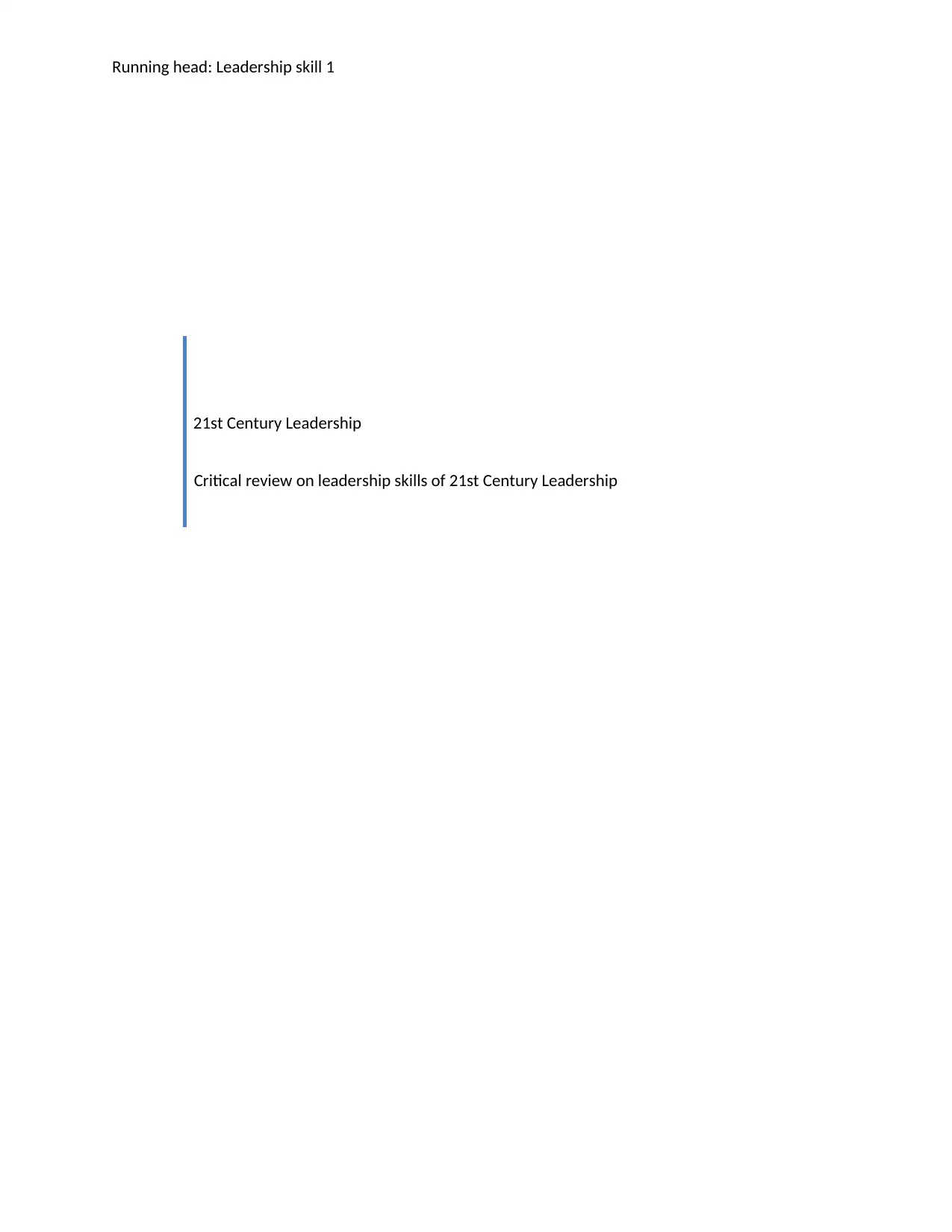
Running head: Leadership skill 1
21st Century Leadership
Critical review on leadership skills of 21st Century Leadership
21st Century Leadership
Critical review on leadership skills of 21st Century Leadership
Paraphrase This Document
Need a fresh take? Get an instant paraphrase of this document with our AI Paraphraser
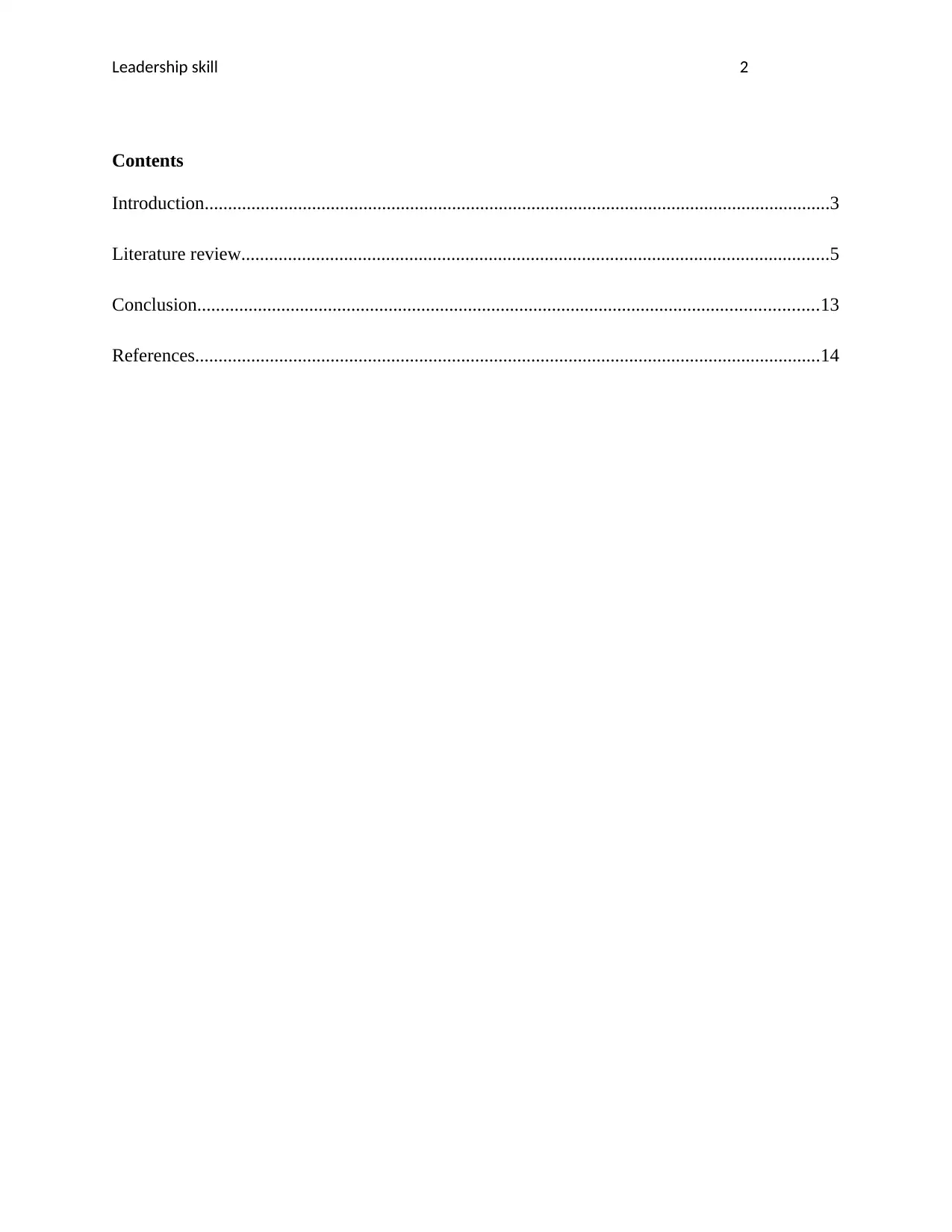
Leadership skill 2
Contents
Introduction......................................................................................................................................3
Literature review..............................................................................................................................5
Conclusion.....................................................................................................................................13
References......................................................................................................................................14
Contents
Introduction......................................................................................................................................3
Literature review..............................................................................................................................5
Conclusion.....................................................................................................................................13
References......................................................................................................................................14
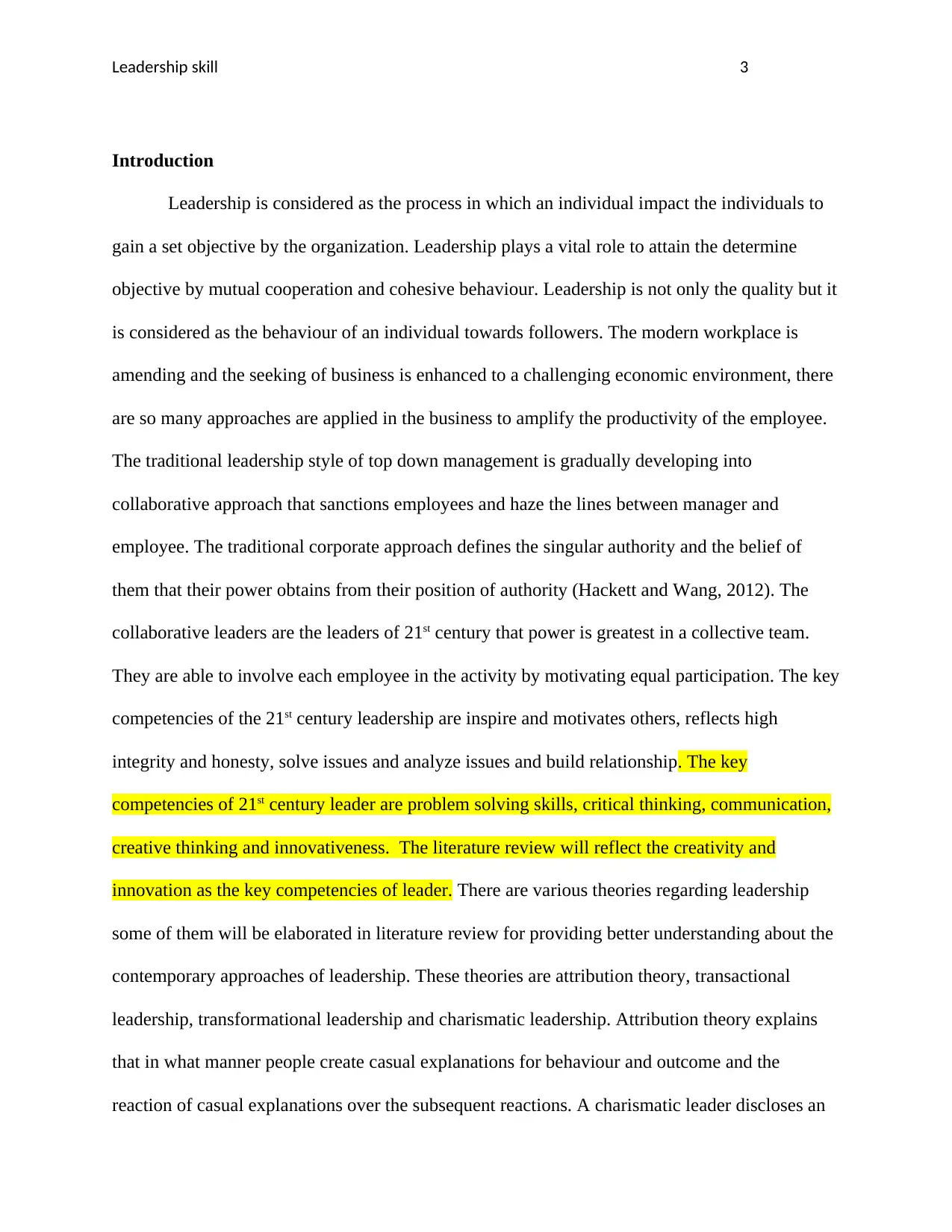
Leadership skill 3
Introduction
Leadership is considered as the process in which an individual impact the individuals to
gain a set objective by the organization. Leadership plays a vital role to attain the determine
objective by mutual cooperation and cohesive behaviour. Leadership is not only the quality but it
is considered as the behaviour of an individual towards followers. The modern workplace is
amending and the seeking of business is enhanced to a challenging economic environment, there
are so many approaches are applied in the business to amplify the productivity of the employee.
The traditional leadership style of top down management is gradually developing into
collaborative approach that sanctions employees and haze the lines between manager and
employee. The traditional corporate approach defines the singular authority and the belief of
them that their power obtains from their position of authority (Hackett and Wang, 2012). The
collaborative leaders are the leaders of 21st century that power is greatest in a collective team.
They are able to involve each employee in the activity by motivating equal participation. The key
competencies of the 21st century leadership are inspire and motivates others, reflects high
integrity and honesty, solve issues and analyze issues and build relationship. The key
competencies of 21st century leader are problem solving skills, critical thinking, communication,
creative thinking and innovativeness. The literature review will reflect the creativity and
innovation as the key competencies of leader. There are various theories regarding leadership
some of them will be elaborated in literature review for providing better understanding about the
contemporary approaches of leadership. These theories are attribution theory, transactional
leadership, transformational leadership and charismatic leadership. Attribution theory explains
that in what manner people create casual explanations for behaviour and outcome and the
reaction of casual explanations over the subsequent reactions. A charismatic leader discloses an
Introduction
Leadership is considered as the process in which an individual impact the individuals to
gain a set objective by the organization. Leadership plays a vital role to attain the determine
objective by mutual cooperation and cohesive behaviour. Leadership is not only the quality but it
is considered as the behaviour of an individual towards followers. The modern workplace is
amending and the seeking of business is enhanced to a challenging economic environment, there
are so many approaches are applied in the business to amplify the productivity of the employee.
The traditional leadership style of top down management is gradually developing into
collaborative approach that sanctions employees and haze the lines between manager and
employee. The traditional corporate approach defines the singular authority and the belief of
them that their power obtains from their position of authority (Hackett and Wang, 2012). The
collaborative leaders are the leaders of 21st century that power is greatest in a collective team.
They are able to involve each employee in the activity by motivating equal participation. The key
competencies of the 21st century leadership are inspire and motivates others, reflects high
integrity and honesty, solve issues and analyze issues and build relationship. The key
competencies of 21st century leader are problem solving skills, critical thinking, communication,
creative thinking and innovativeness. The literature review will reflect the creativity and
innovation as the key competencies of leader. There are various theories regarding leadership
some of them will be elaborated in literature review for providing better understanding about the
contemporary approaches of leadership. These theories are attribution theory, transactional
leadership, transformational leadership and charismatic leadership. Attribution theory explains
that in what manner people create casual explanations for behaviour and outcome and the
reaction of casual explanations over the subsequent reactions. A charismatic leader discloses an
⊘ This is a preview!⊘
Do you want full access?
Subscribe today to unlock all pages.

Trusted by 1+ million students worldwide
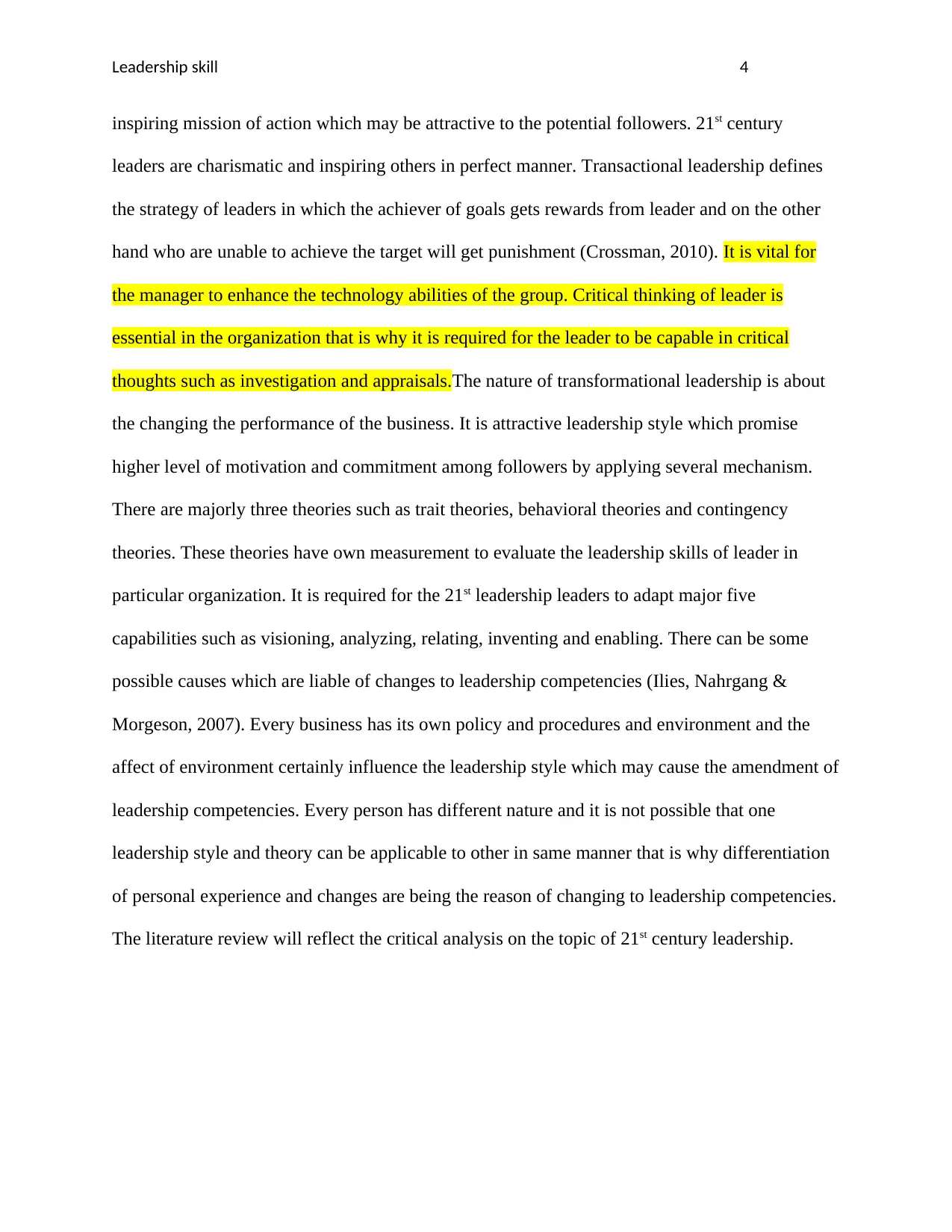
Leadership skill 4
inspiring mission of action which may be attractive to the potential followers. 21st century
leaders are charismatic and inspiring others in perfect manner. Transactional leadership defines
the strategy of leaders in which the achiever of goals gets rewards from leader and on the other
hand who are unable to achieve the target will get punishment (Crossman, 2010). It is vital for
the manager to enhance the technology abilities of the group. Critical thinking of leader is
essential in the organization that is why it is required for the leader to be capable in critical
thoughts such as investigation and appraisals.The nature of transformational leadership is about
the changing the performance of the business. It is attractive leadership style which promise
higher level of motivation and commitment among followers by applying several mechanism.
There are majorly three theories such as trait theories, behavioral theories and contingency
theories. These theories have own measurement to evaluate the leadership skills of leader in
particular organization. It is required for the 21st leadership leaders to adapt major five
capabilities such as visioning, analyzing, relating, inventing and enabling. There can be some
possible causes which are liable of changes to leadership competencies (Ilies, Nahrgang &
Morgeson, 2007). Every business has its own policy and procedures and environment and the
affect of environment certainly influence the leadership style which may cause the amendment of
leadership competencies. Every person has different nature and it is not possible that one
leadership style and theory can be applicable to other in same manner that is why differentiation
of personal experience and changes are being the reason of changing to leadership competencies.
The literature review will reflect the critical analysis on the topic of 21st century leadership.
inspiring mission of action which may be attractive to the potential followers. 21st century
leaders are charismatic and inspiring others in perfect manner. Transactional leadership defines
the strategy of leaders in which the achiever of goals gets rewards from leader and on the other
hand who are unable to achieve the target will get punishment (Crossman, 2010). It is vital for
the manager to enhance the technology abilities of the group. Critical thinking of leader is
essential in the organization that is why it is required for the leader to be capable in critical
thoughts such as investigation and appraisals.The nature of transformational leadership is about
the changing the performance of the business. It is attractive leadership style which promise
higher level of motivation and commitment among followers by applying several mechanism.
There are majorly three theories such as trait theories, behavioral theories and contingency
theories. These theories have own measurement to evaluate the leadership skills of leader in
particular organization. It is required for the 21st leadership leaders to adapt major five
capabilities such as visioning, analyzing, relating, inventing and enabling. There can be some
possible causes which are liable of changes to leadership competencies (Ilies, Nahrgang &
Morgeson, 2007). Every business has its own policy and procedures and environment and the
affect of environment certainly influence the leadership style which may cause the amendment of
leadership competencies. Every person has different nature and it is not possible that one
leadership style and theory can be applicable to other in same manner that is why differentiation
of personal experience and changes are being the reason of changing to leadership competencies.
The literature review will reflect the critical analysis on the topic of 21st century leadership.
Paraphrase This Document
Need a fresh take? Get an instant paraphrase of this document with our AI Paraphraser
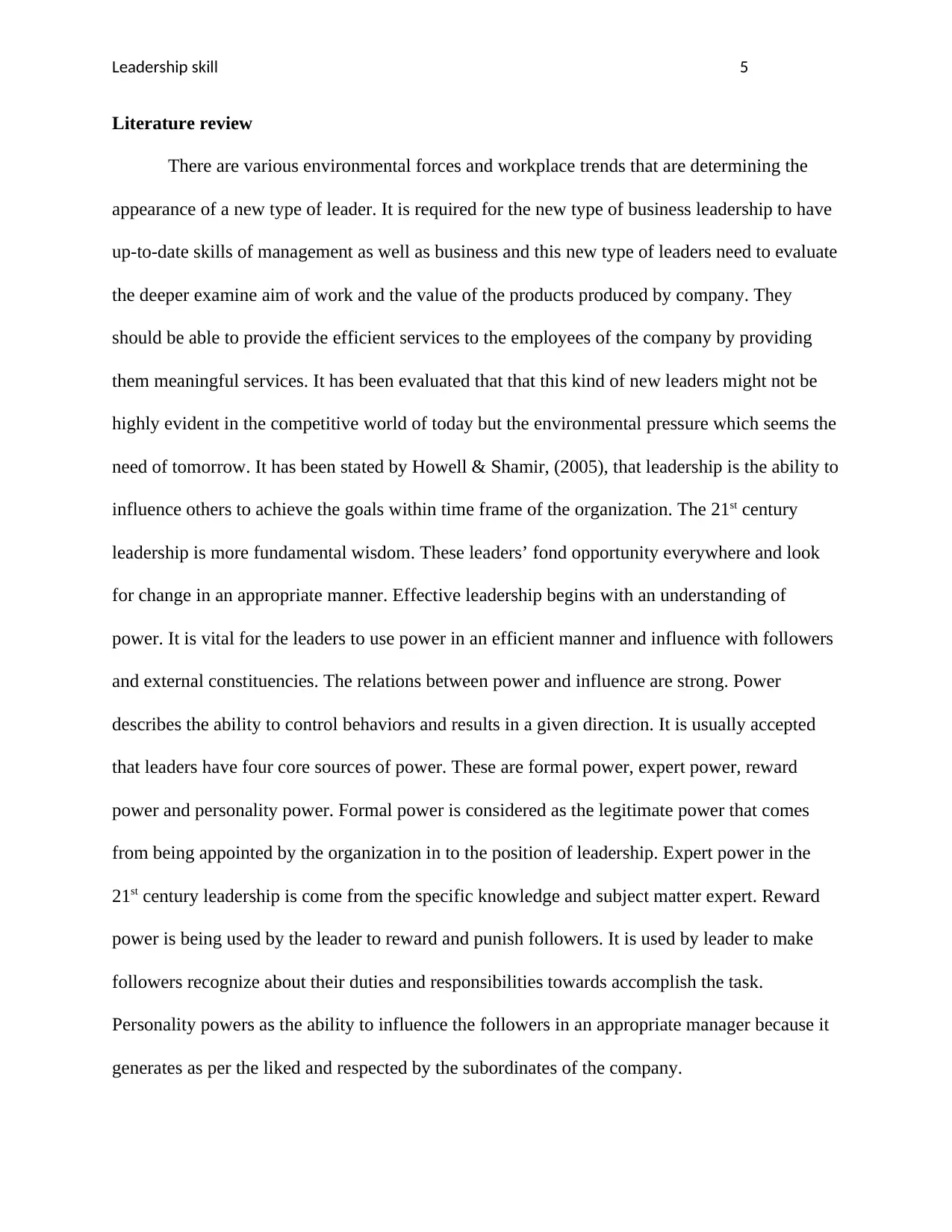
Leadership skill 5
Literature review
There are various environmental forces and workplace trends that are determining the
appearance of a new type of leader. It is required for the new type of business leadership to have
up-to-date skills of management as well as business and this new type of leaders need to evaluate
the deeper examine aim of work and the value of the products produced by company. They
should be able to provide the efficient services to the employees of the company by providing
them meaningful services. It has been evaluated that that this kind of new leaders might not be
highly evident in the competitive world of today but the environmental pressure which seems the
need of tomorrow. It has been stated by Howell & Shamir, (2005), that leadership is the ability to
influence others to achieve the goals within time frame of the organization. The 21st century
leadership is more fundamental wisdom. These leaders’ fond opportunity everywhere and look
for change in an appropriate manner. Effective leadership begins with an understanding of
power. It is vital for the leaders to use power in an efficient manner and influence with followers
and external constituencies. The relations between power and influence are strong. Power
describes the ability to control behaviors and results in a given direction. It is usually accepted
that leaders have four core sources of power. These are formal power, expert power, reward
power and personality power. Formal power is considered as the legitimate power that comes
from being appointed by the organization in to the position of leadership. Expert power in the
21st century leadership is come from the specific knowledge and subject matter expert. Reward
power is being used by the leader to reward and punish followers. It is used by leader to make
followers recognize about their duties and responsibilities towards accomplish the task.
Personality powers as the ability to influence the followers in an appropriate manager because it
generates as per the liked and respected by the subordinates of the company.
Literature review
There are various environmental forces and workplace trends that are determining the
appearance of a new type of leader. It is required for the new type of business leadership to have
up-to-date skills of management as well as business and this new type of leaders need to evaluate
the deeper examine aim of work and the value of the products produced by company. They
should be able to provide the efficient services to the employees of the company by providing
them meaningful services. It has been evaluated that that this kind of new leaders might not be
highly evident in the competitive world of today but the environmental pressure which seems the
need of tomorrow. It has been stated by Howell & Shamir, (2005), that leadership is the ability to
influence others to achieve the goals within time frame of the organization. The 21st century
leadership is more fundamental wisdom. These leaders’ fond opportunity everywhere and look
for change in an appropriate manner. Effective leadership begins with an understanding of
power. It is vital for the leaders to use power in an efficient manner and influence with followers
and external constituencies. The relations between power and influence are strong. Power
describes the ability to control behaviors and results in a given direction. It is usually accepted
that leaders have four core sources of power. These are formal power, expert power, reward
power and personality power. Formal power is considered as the legitimate power that comes
from being appointed by the organization in to the position of leadership. Expert power in the
21st century leadership is come from the specific knowledge and subject matter expert. Reward
power is being used by the leader to reward and punish followers. It is used by leader to make
followers recognize about their duties and responsibilities towards accomplish the task.
Personality powers as the ability to influence the followers in an appropriate manager because it
generates as per the liked and respected by the subordinates of the company.
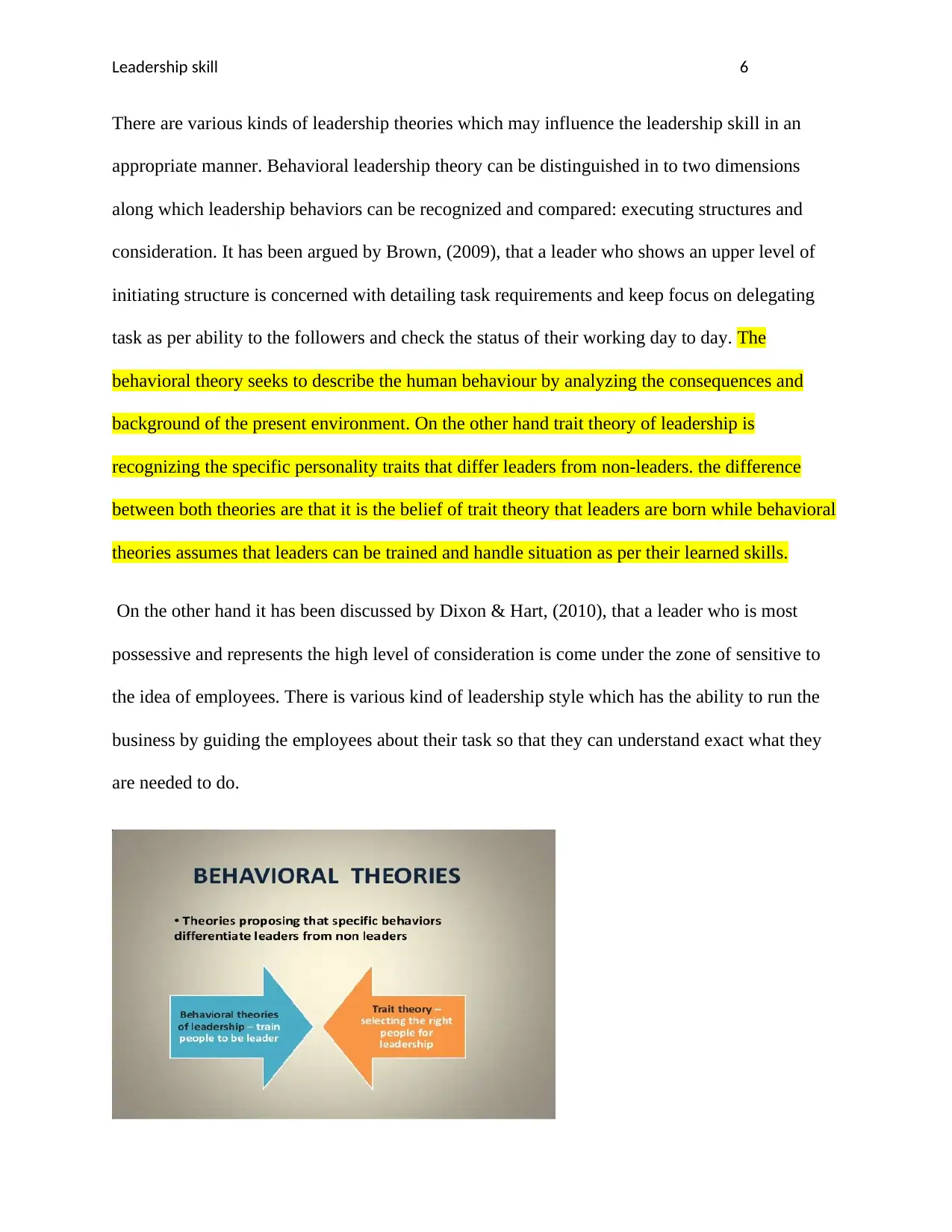
Leadership skill 6
There are various kinds of leadership theories which may influence the leadership skill in an
appropriate manner. Behavioral leadership theory can be distinguished in to two dimensions
along which leadership behaviors can be recognized and compared: executing structures and
consideration. It has been argued by Brown, (2009), that a leader who shows an upper level of
initiating structure is concerned with detailing task requirements and keep focus on delegating
task as per ability to the followers and check the status of their working day to day. The
behavioral theory seeks to describe the human behaviour by analyzing the consequences and
background of the present environment. On the other hand trait theory of leadership is
recognizing the specific personality traits that differ leaders from non-leaders. the difference
between both theories are that it is the belief of trait theory that leaders are born while behavioral
theories assumes that leaders can be trained and handle situation as per their learned skills.
On the other hand it has been discussed by Dixon & Hart, (2010), that a leader who is most
possessive and represents the high level of consideration is come under the zone of sensitive to
the idea of employees. There is various kind of leadership style which has the ability to run the
business by guiding the employees about their task so that they can understand exact what they
are needed to do.
There are various kinds of leadership theories which may influence the leadership skill in an
appropriate manner. Behavioral leadership theory can be distinguished in to two dimensions
along which leadership behaviors can be recognized and compared: executing structures and
consideration. It has been argued by Brown, (2009), that a leader who shows an upper level of
initiating structure is concerned with detailing task requirements and keep focus on delegating
task as per ability to the followers and check the status of their working day to day. The
behavioral theory seeks to describe the human behaviour by analyzing the consequences and
background of the present environment. On the other hand trait theory of leadership is
recognizing the specific personality traits that differ leaders from non-leaders. the difference
between both theories are that it is the belief of trait theory that leaders are born while behavioral
theories assumes that leaders can be trained and handle situation as per their learned skills.
On the other hand it has been discussed by Dixon & Hart, (2010), that a leader who is most
possessive and represents the high level of consideration is come under the zone of sensitive to
the idea of employees. There is various kind of leadership style which has the ability to run the
business by guiding the employees about their task so that they can understand exact what they
are needed to do.
⊘ This is a preview!⊘
Do you want full access?
Subscribe today to unlock all pages.

Trusted by 1+ million students worldwide
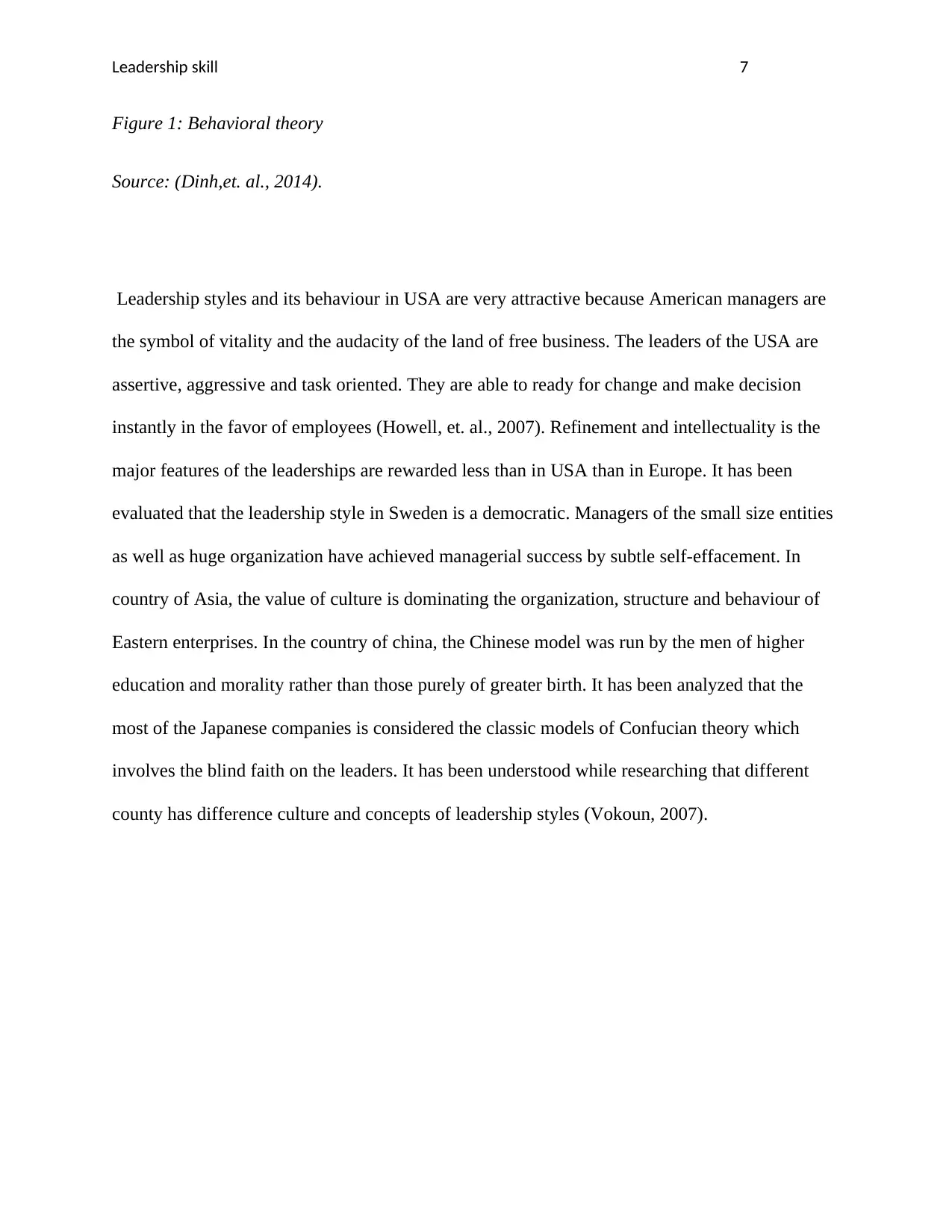
Leadership skill 7
Figure 1: Behavioral theory
Source: (Dinh,et. al., 2014).
Leadership styles and its behaviour in USA are very attractive because American managers are
the symbol of vitality and the audacity of the land of free business. The leaders of the USA are
assertive, aggressive and task oriented. They are able to ready for change and make decision
instantly in the favor of employees (Howell, et. al., 2007). Refinement and intellectuality is the
major features of the leaderships are rewarded less than in USA than in Europe. It has been
evaluated that the leadership style in Sweden is a democratic. Managers of the small size entities
as well as huge organization have achieved managerial success by subtle self-effacement. In
country of Asia, the value of culture is dominating the organization, structure and behaviour of
Eastern enterprises. In the country of china, the Chinese model was run by the men of higher
education and morality rather than those purely of greater birth. It has been analyzed that the
most of the Japanese companies is considered the classic models of Confucian theory which
involves the blind faith on the leaders. It has been understood while researching that different
county has difference culture and concepts of leadership styles (Vokoun, 2007).
Figure 1: Behavioral theory
Source: (Dinh,et. al., 2014).
Leadership styles and its behaviour in USA are very attractive because American managers are
the symbol of vitality and the audacity of the land of free business. The leaders of the USA are
assertive, aggressive and task oriented. They are able to ready for change and make decision
instantly in the favor of employees (Howell, et. al., 2007). Refinement and intellectuality is the
major features of the leaderships are rewarded less than in USA than in Europe. It has been
evaluated that the leadership style in Sweden is a democratic. Managers of the small size entities
as well as huge organization have achieved managerial success by subtle self-effacement. In
country of Asia, the value of culture is dominating the organization, structure and behaviour of
Eastern enterprises. In the country of china, the Chinese model was run by the men of higher
education and morality rather than those purely of greater birth. It has been analyzed that the
most of the Japanese companies is considered the classic models of Confucian theory which
involves the blind faith on the leaders. It has been understood while researching that different
county has difference culture and concepts of leadership styles (Vokoun, 2007).
Paraphrase This Document
Need a fresh take? Get an instant paraphrase of this document with our AI Paraphraser
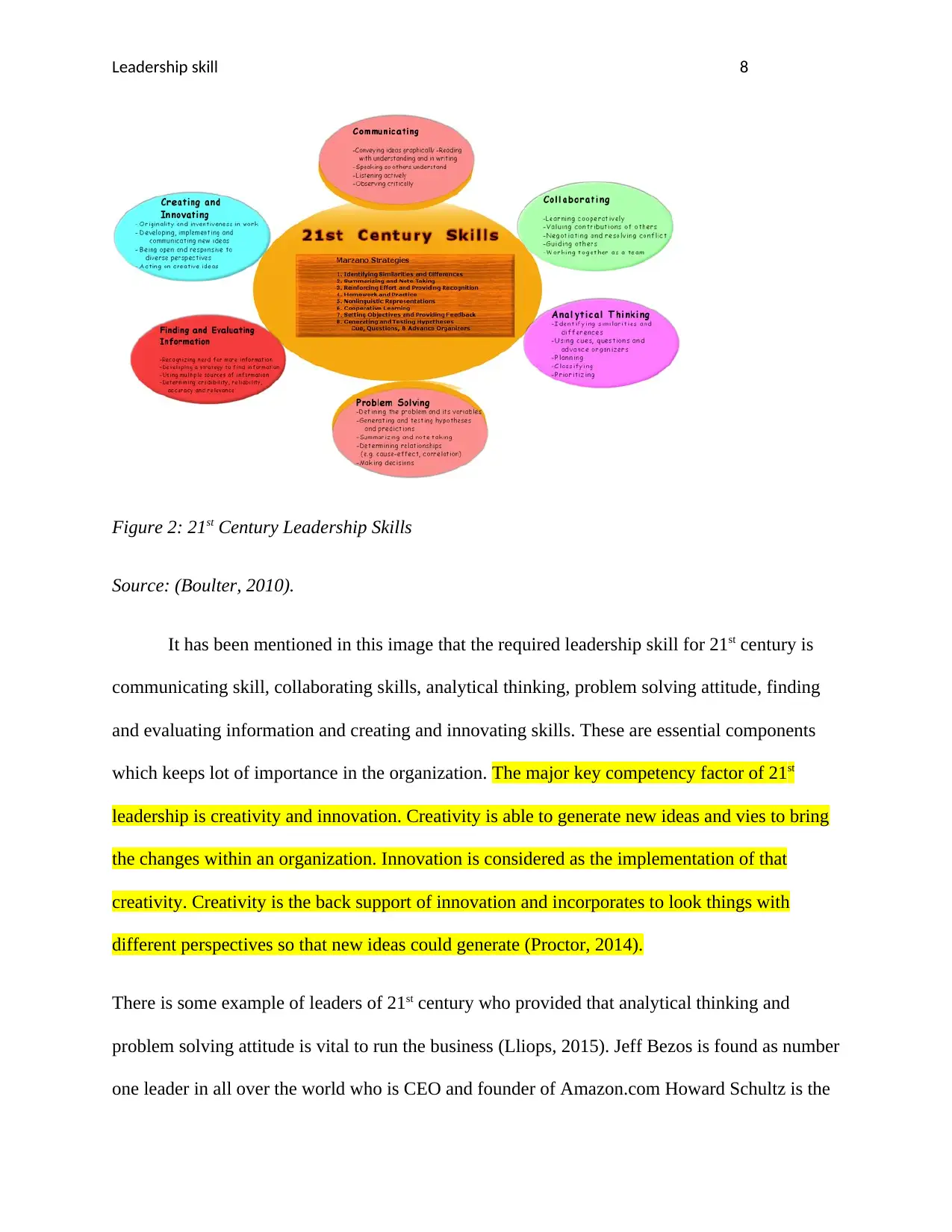
Leadership skill 8
Figure 2: 21st Century Leadership Skills
Source: (Boulter, 2010).
It has been mentioned in this image that the required leadership skill for 21st century is
communicating skill, collaborating skills, analytical thinking, problem solving attitude, finding
and evaluating information and creating and innovating skills. These are essential components
which keeps lot of importance in the organization. The major key competency factor of 21st
leadership is creativity and innovation. Creativity is able to generate new ideas and vies to bring
the changes within an organization. Innovation is considered as the implementation of that
creativity. Creativity is the back support of innovation and incorporates to look things with
different perspectives so that new ideas could generate (Proctor, 2014).
There is some example of leaders of 21st century who provided that analytical thinking and
problem solving attitude is vital to run the business (Lliops, 2015). Jeff Bezos is found as number
one leader in all over the world who is CEO and founder of Amazon.com Howard Schultz is the
Figure 2: 21st Century Leadership Skills
Source: (Boulter, 2010).
It has been mentioned in this image that the required leadership skill for 21st century is
communicating skill, collaborating skills, analytical thinking, problem solving attitude, finding
and evaluating information and creating and innovating skills. These are essential components
which keeps lot of importance in the organization. The major key competency factor of 21st
leadership is creativity and innovation. Creativity is able to generate new ideas and vies to bring
the changes within an organization. Innovation is considered as the implementation of that
creativity. Creativity is the back support of innovation and incorporates to look things with
different perspectives so that new ideas could generate (Proctor, 2014).
There is some example of leaders of 21st century who provided that analytical thinking and
problem solving attitude is vital to run the business (Lliops, 2015). Jeff Bezos is found as number
one leader in all over the world who is CEO and founder of Amazon.com Howard Schultz is the
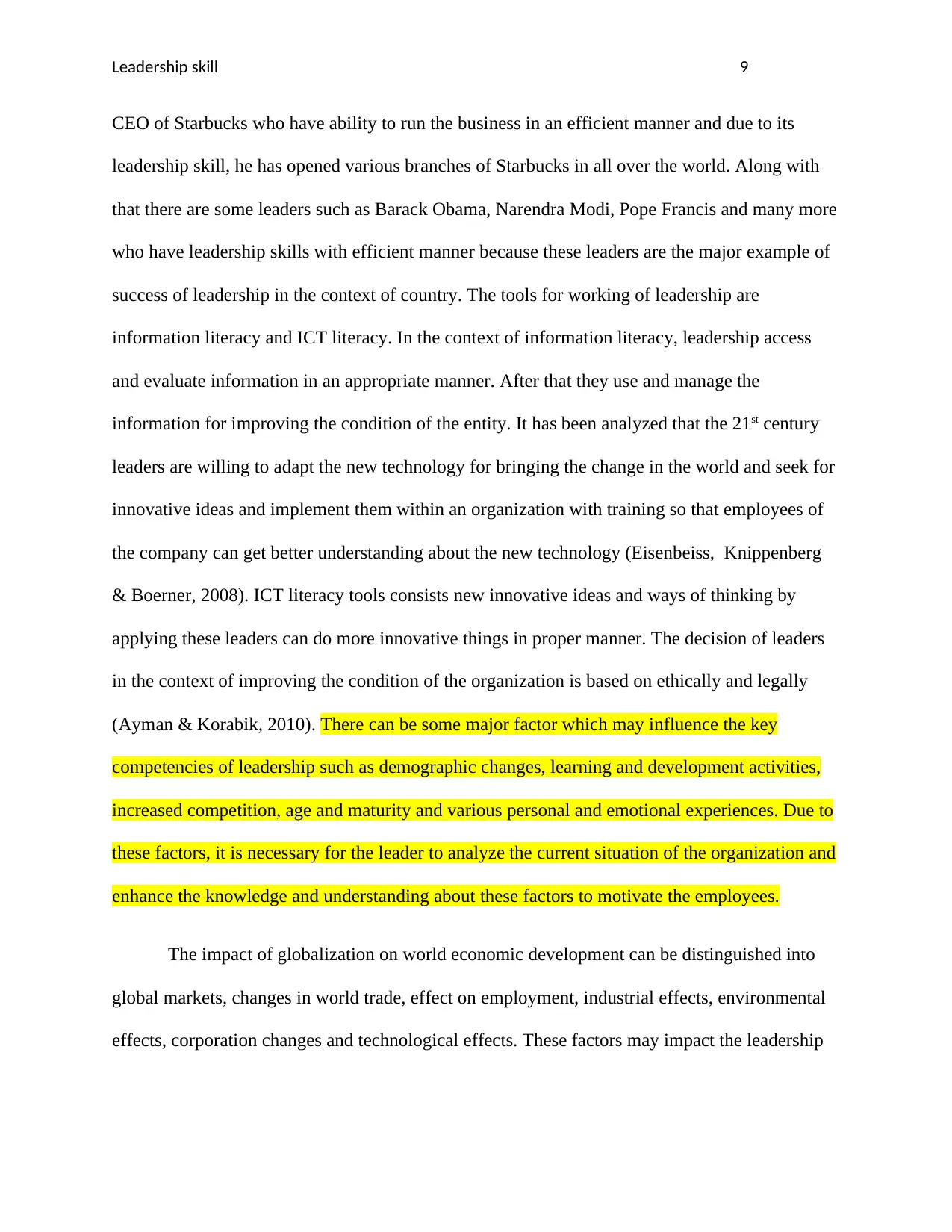
Leadership skill 9
CEO of Starbucks who have ability to run the business in an efficient manner and due to its
leadership skill, he has opened various branches of Starbucks in all over the world. Along with
that there are some leaders such as Barack Obama, Narendra Modi, Pope Francis and many more
who have leadership skills with efficient manner because these leaders are the major example of
success of leadership in the context of country. The tools for working of leadership are
information literacy and ICT literacy. In the context of information literacy, leadership access
and evaluate information in an appropriate manner. After that they use and manage the
information for improving the condition of the entity. It has been analyzed that the 21st century
leaders are willing to adapt the new technology for bringing the change in the world and seek for
innovative ideas and implement them within an organization with training so that employees of
the company can get better understanding about the new technology (Eisenbeiss, Knippenberg
& Boerner, 2008). ICT literacy tools consists new innovative ideas and ways of thinking by
applying these leaders can do more innovative things in proper manner. The decision of leaders
in the context of improving the condition of the organization is based on ethically and legally
(Ayman & Korabik, 2010). There can be some major factor which may influence the key
competencies of leadership such as demographic changes, learning and development activities,
increased competition, age and maturity and various personal and emotional experiences. Due to
these factors, it is necessary for the leader to analyze the current situation of the organization and
enhance the knowledge and understanding about these factors to motivate the employees.
The impact of globalization on world economic development can be distinguished into
global markets, changes in world trade, effect on employment, industrial effects, environmental
effects, corporation changes and technological effects. These factors may impact the leadership
CEO of Starbucks who have ability to run the business in an efficient manner and due to its
leadership skill, he has opened various branches of Starbucks in all over the world. Along with
that there are some leaders such as Barack Obama, Narendra Modi, Pope Francis and many more
who have leadership skills with efficient manner because these leaders are the major example of
success of leadership in the context of country. The tools for working of leadership are
information literacy and ICT literacy. In the context of information literacy, leadership access
and evaluate information in an appropriate manner. After that they use and manage the
information for improving the condition of the entity. It has been analyzed that the 21st century
leaders are willing to adapt the new technology for bringing the change in the world and seek for
innovative ideas and implement them within an organization with training so that employees of
the company can get better understanding about the new technology (Eisenbeiss, Knippenberg
& Boerner, 2008). ICT literacy tools consists new innovative ideas and ways of thinking by
applying these leaders can do more innovative things in proper manner. The decision of leaders
in the context of improving the condition of the organization is based on ethically and legally
(Ayman & Korabik, 2010). There can be some major factor which may influence the key
competencies of leadership such as demographic changes, learning and development activities,
increased competition, age and maturity and various personal and emotional experiences. Due to
these factors, it is necessary for the leader to analyze the current situation of the organization and
enhance the knowledge and understanding about these factors to motivate the employees.
The impact of globalization on world economic development can be distinguished into
global markets, changes in world trade, effect on employment, industrial effects, environmental
effects, corporation changes and technological effects. These factors may impact the leadership
⊘ This is a preview!⊘
Do you want full access?
Subscribe today to unlock all pages.

Trusted by 1+ million students worldwide
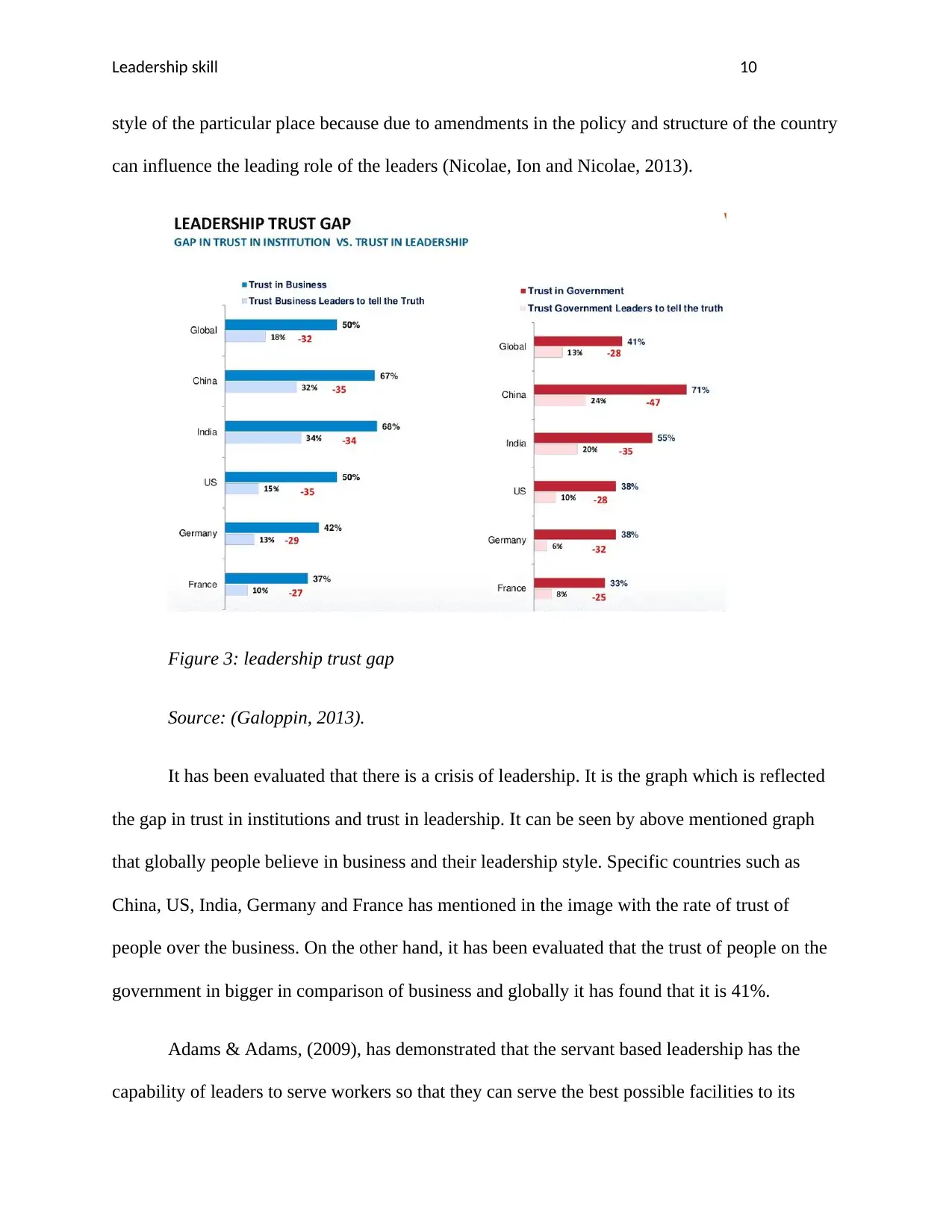
Leadership skill 10
style of the particular place because due to amendments in the policy and structure of the country
can influence the leading role of the leaders (Nicolae, Ion and Nicolae, 2013).
Figure 3: leadership trust gap
Source: (Galoppin, 2013).
It has been evaluated that there is a crisis of leadership. It is the graph which is reflected
the gap in trust in institutions and trust in leadership. It can be seen by above mentioned graph
that globally people believe in business and their leadership style. Specific countries such as
China, US, India, Germany and France has mentioned in the image with the rate of trust of
people over the business. On the other hand, it has been evaluated that the trust of people on the
government in bigger in comparison of business and globally it has found that it is 41%.
Adams & Adams, (2009), has demonstrated that the servant based leadership has the
capability of leaders to serve workers so that they can serve the best possible facilities to its
style of the particular place because due to amendments in the policy and structure of the country
can influence the leading role of the leaders (Nicolae, Ion and Nicolae, 2013).
Figure 3: leadership trust gap
Source: (Galoppin, 2013).
It has been evaluated that there is a crisis of leadership. It is the graph which is reflected
the gap in trust in institutions and trust in leadership. It can be seen by above mentioned graph
that globally people believe in business and their leadership style. Specific countries such as
China, US, India, Germany and France has mentioned in the image with the rate of trust of
people over the business. On the other hand, it has been evaluated that the trust of people on the
government in bigger in comparison of business and globally it has found that it is 41%.
Adams & Adams, (2009), has demonstrated that the servant based leadership has the
capability of leaders to serve workers so that they can serve the best possible facilities to its
Paraphrase This Document
Need a fresh take? Get an instant paraphrase of this document with our AI Paraphraser
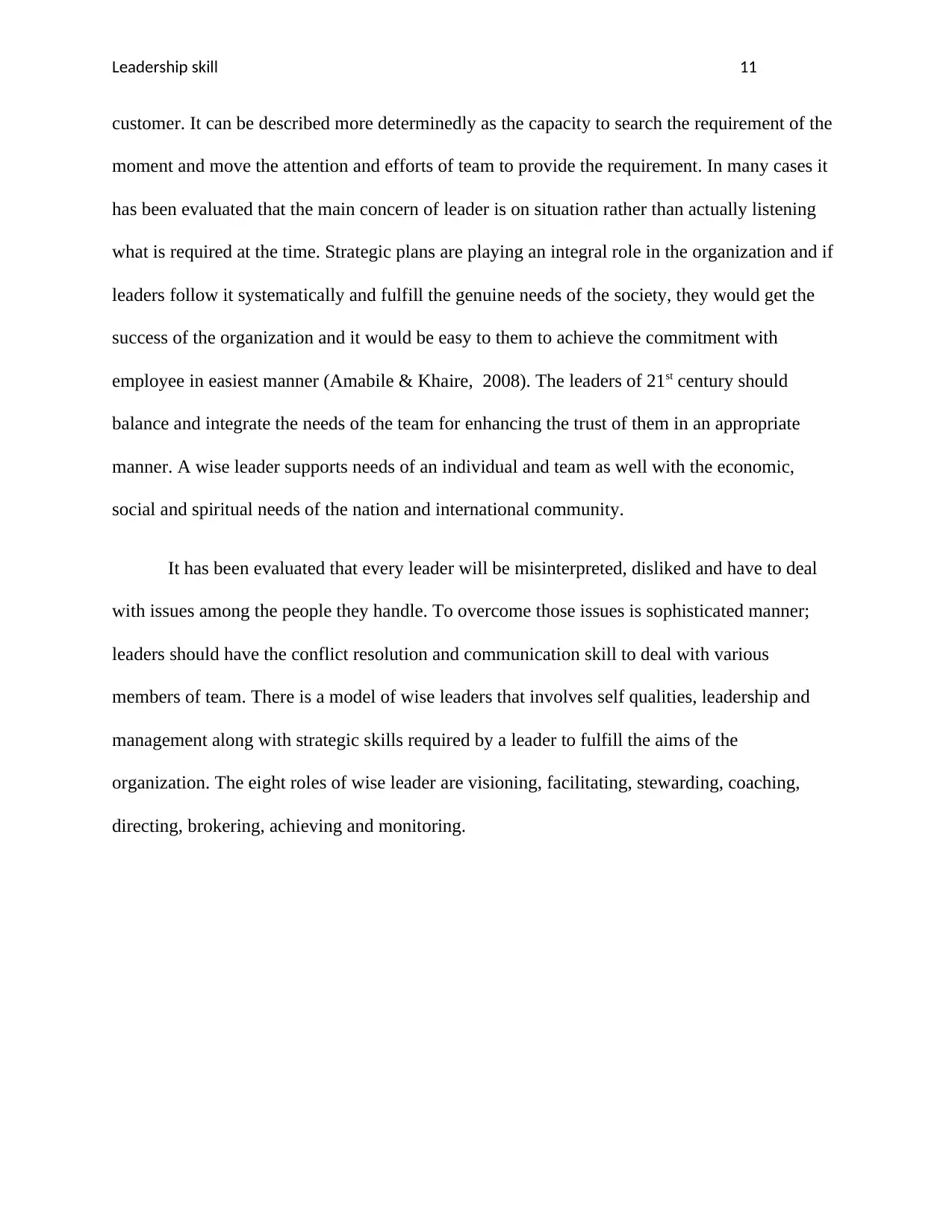
Leadership skill 11
customer. It can be described more determinedly as the capacity to search the requirement of the
moment and move the attention and efforts of team to provide the requirement. In many cases it
has been evaluated that the main concern of leader is on situation rather than actually listening
what is required at the time. Strategic plans are playing an integral role in the organization and if
leaders follow it systematically and fulfill the genuine needs of the society, they would get the
success of the organization and it would be easy to them to achieve the commitment with
employee in easiest manner (Amabile & Khaire, 2008). The leaders of 21st century should
balance and integrate the needs of the team for enhancing the trust of them in an appropriate
manner. A wise leader supports needs of an individual and team as well with the economic,
social and spiritual needs of the nation and international community.
It has been evaluated that every leader will be misinterpreted, disliked and have to deal
with issues among the people they handle. To overcome those issues is sophisticated manner;
leaders should have the conflict resolution and communication skill to deal with various
members of team. There is a model of wise leaders that involves self qualities, leadership and
management along with strategic skills required by a leader to fulfill the aims of the
organization. The eight roles of wise leader are visioning, facilitating, stewarding, coaching,
directing, brokering, achieving and monitoring.
customer. It can be described more determinedly as the capacity to search the requirement of the
moment and move the attention and efforts of team to provide the requirement. In many cases it
has been evaluated that the main concern of leader is on situation rather than actually listening
what is required at the time. Strategic plans are playing an integral role in the organization and if
leaders follow it systematically and fulfill the genuine needs of the society, they would get the
success of the organization and it would be easy to them to achieve the commitment with
employee in easiest manner (Amabile & Khaire, 2008). The leaders of 21st century should
balance and integrate the needs of the team for enhancing the trust of them in an appropriate
manner. A wise leader supports needs of an individual and team as well with the economic,
social and spiritual needs of the nation and international community.
It has been evaluated that every leader will be misinterpreted, disliked and have to deal
with issues among the people they handle. To overcome those issues is sophisticated manner;
leaders should have the conflict resolution and communication skill to deal with various
members of team. There is a model of wise leaders that involves self qualities, leadership and
management along with strategic skills required by a leader to fulfill the aims of the
organization. The eight roles of wise leader are visioning, facilitating, stewarding, coaching,
directing, brokering, achieving and monitoring.
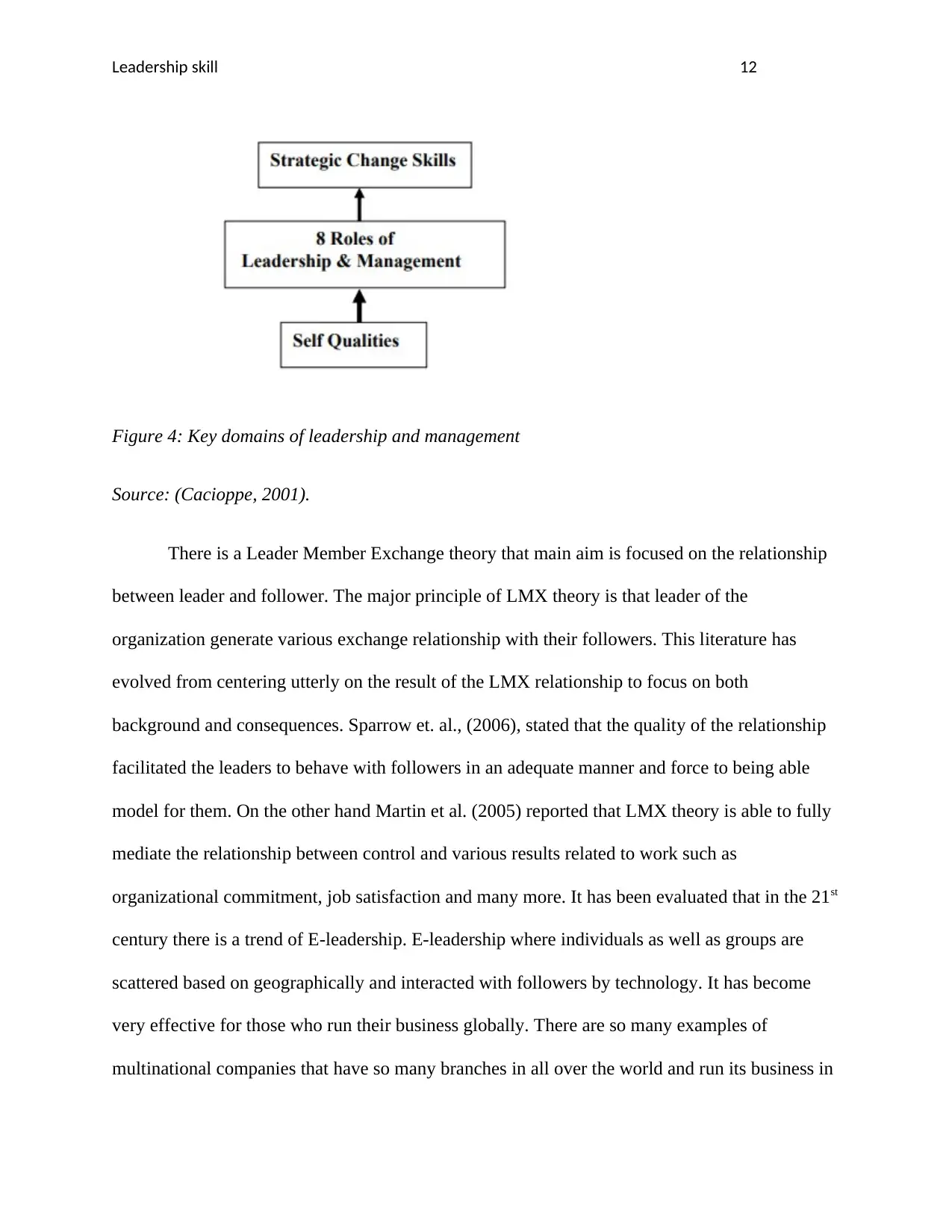
Leadership skill 12
Figure 4: Key domains of leadership and management
Source: (Cacioppe, 2001).
There is a Leader Member Exchange theory that main aim is focused on the relationship
between leader and follower. The major principle of LMX theory is that leader of the
organization generate various exchange relationship with their followers. This literature has
evolved from centering utterly on the result of the LMX relationship to focus on both
background and consequences. Sparrow et. al., (2006), stated that the quality of the relationship
facilitated the leaders to behave with followers in an adequate manner and force to being able
model for them. On the other hand Martin et al. (2005) reported that LMX theory is able to fully
mediate the relationship between control and various results related to work such as
organizational commitment, job satisfaction and many more. It has been evaluated that in the 21st
century there is a trend of E-leadership. E-leadership where individuals as well as groups are
scattered based on geographically and interacted with followers by technology. It has become
very effective for those who run their business globally. There are so many examples of
multinational companies that have so many branches in all over the world and run its business in
Figure 4: Key domains of leadership and management
Source: (Cacioppe, 2001).
There is a Leader Member Exchange theory that main aim is focused on the relationship
between leader and follower. The major principle of LMX theory is that leader of the
organization generate various exchange relationship with their followers. This literature has
evolved from centering utterly on the result of the LMX relationship to focus on both
background and consequences. Sparrow et. al., (2006), stated that the quality of the relationship
facilitated the leaders to behave with followers in an adequate manner and force to being able
model for them. On the other hand Martin et al. (2005) reported that LMX theory is able to fully
mediate the relationship between control and various results related to work such as
organizational commitment, job satisfaction and many more. It has been evaluated that in the 21st
century there is a trend of E-leadership. E-leadership where individuals as well as groups are
scattered based on geographically and interacted with followers by technology. It has become
very effective for those who run their business globally. There are so many examples of
multinational companies that have so many branches in all over the world and run its business in
⊘ This is a preview!⊘
Do you want full access?
Subscribe today to unlock all pages.

Trusted by 1+ million students worldwide
1 out of 18
Related Documents
Your All-in-One AI-Powered Toolkit for Academic Success.
+13062052269
info@desklib.com
Available 24*7 on WhatsApp / Email
![[object Object]](/_next/static/media/star-bottom.7253800d.svg)
Unlock your academic potential
Copyright © 2020–2025 A2Z Services. All Rights Reserved. Developed and managed by ZUCOL.




